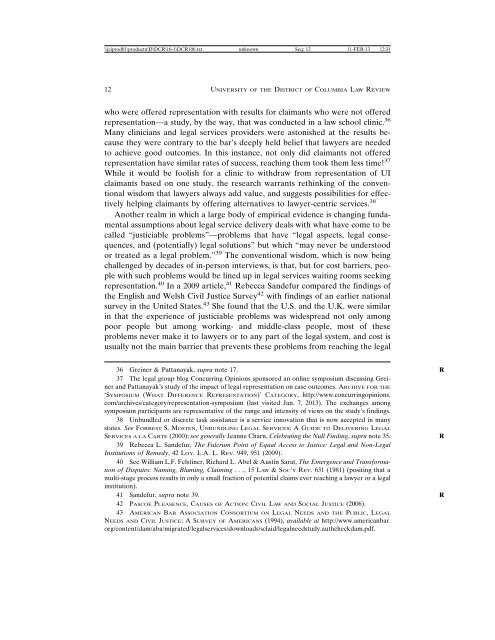volume 16, number 1 - UDC Law Review
volume 16, number 1 - UDC Law Review
volume 16, number 1 - UDC Law Review
- No tags were found...
You also want an ePaper? Increase the reach of your titles
YUMPU automatically turns print PDFs into web optimized ePapers that Google loves.
\\jciprod01\productn\D\DCR\<strong>16</strong>-1\DCR106.txt unknown Seq: 12 11-FEB-13 12:3112 UNIVERSITY OF THE DISTRICT OF COLUMBIA LAW REVIEWwho were offered representation with results for claimants who were not offeredrepresentation—a study, by the way, that was conducted in a law school clinic. 36Many clinicians and legal services providers were astonished at the results becausethey were contrary to the bar’s deeply held belief that lawyers are neededto achieve good outcomes. In this instance, not only did claimants not offeredrepresentation have similar rates of success, reaching them took them less time! 37While it would be foolish for a clinic to withdraw from representation of UIclaimants based on one study, the research warrants rethinking of the conventionalwisdom that lawyers always add value, and suggests possibilities for effectivelyhelping claimants by offering alternatives to lawyer-centric services. 38Another realm in which a large body of empirical evidence is changing fundamentalassumptions about legal service delivery deals with what have come to becalled “justiciable problems”—problems that have “legal aspects, legal consequences,and (potentially) legal solutions” but which “may never be understoodor treated as a legal problem.” 39 The conventional wisdom, which is now beingchallenged by decades of in-person interviews, is that, but for cost barriers, peoplewith such problems would be lined up in legal services waiting rooms seekingrepresentation. 40 In a 2009 article, 41 Rebecca Sandefur compared the findings ofthe English and Welsh Civil Justice Survey 42 with findings of an earlier nationalsurvey in the United States. 43 She found that the U.S. and the U.K. were similarin that the experience of justiciable problems was widespread not only amongpoor people but among working- and middle-class people, most of theseproblems never make it to lawyers or to any part of the legal system, and cost isusually not the main barrier that prevents these problems from reaching the legal36 Greiner & Pattanayak, supra note 17. R37 The legal group blog Concurring Opinions sponsored an online symposium discussing Greinerand Pattanayak’s study of the impact of legal representation on case outcomes. ARCHIVE FOR THE‘SYMPOSIUM (WHAT DIFFERENCE REPRESENTATION)’ CATEGORY, http://www.concurringopinions.com/archives/category/representation-symposium (last visited Jan. 7, 2013). The exchanges amongsymposium participants are representative of the range and intensity of views on the study’s findings.38 Unbundled or discrete task assistance is a service innovation that is now accepted in manystates. See FORREST S. MOSTEN, UNBUNDLING LEGAL SERVICES: A GUIDE TO DELIVERING LEGALSERVICES A LA CARTE (2000); see generally Jeanne Charn, Celebrating the Null Finding, supra note 35.R39 Rebecca L. Sandefur, The Fulcrum Point of Equal Access to Justice: Legal and Non-LegalInstitutions of Remedy, 42 LOY. L.A. L. REV. 949, 951 (2009).40 See William L.F. Felstiner, Richard L. Abel & Austin Sarat, The Emergence and Transformationof Disputes: Naming, Blaming, Claiming . . ., 15 LAW & SOC’Y REV. 631 (1981) (positing that amulti-stage process results in only a small fraction of potential claims ever reaching a lawyer or a legalinstitution).41 Sandefur, supra note 39. R42 PASCOE PLEASENCE, CAUSES OF ACTION: CIVIL LAW AND SOCIAL JUSTICE (2006).43 AMERICAN BAR ASSOCIATION CONSORTIUM ON LEGAL NEEDS AND THE PUBLIC, LEGALNEEDS AND CIVIL JUSTICE: A SURVEY OF AMERICANS (1994), available at http://www.americanbar.org/content/dam/aba/migrated/legalservices/downloads/sclaid/legalneedstudy.authcheckdam.pdf.














